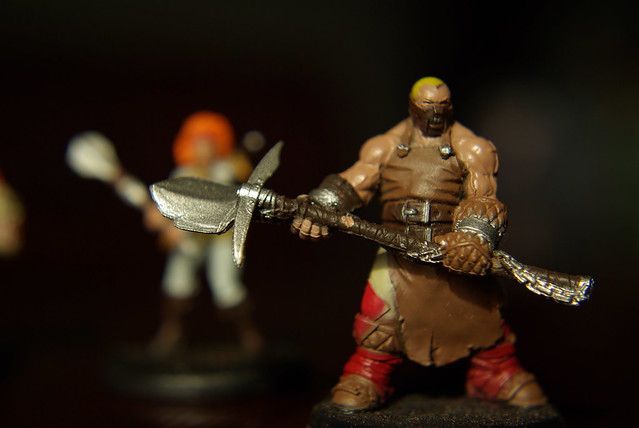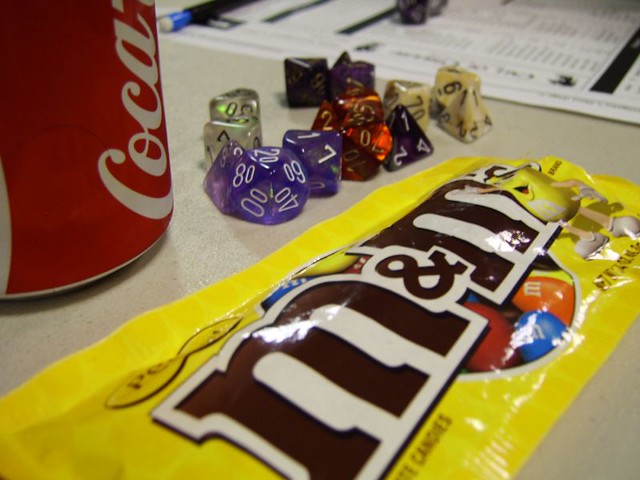This is a beautiful shot.
It seems very nicely composed, and clearly tells part of a story. He's a hair blurry, which shows that he's not the focal point, here - she's in very sharp focus, making it clear that it's her story. The foreground lighting is perfect, here, too. To be honest, the only thing I dislike about this photo is the presence of people in the background. I've considered darkening the background a bit further to hide the other people and make the dancers stand out a bit better.
It's also something I salvaged from a ... less-good shot.
Let's see if I can get that "break" thing right, so you can see the original shot.
Tuesday, May 29, 2012
Tuesday, May 22, 2012
A Few Of My Favorite Things
Different photographers specialize in different things. I wonder if professional photographers choose their goal or if they are just drawn to specific things.
Me? I love game components and the cultural markers that gamers tend to gather around themselves.
In fact, I'm finding more and more that my favorite photos are all game-related.
Almost without fail.
See what I mean?
Every one of these photos was taken while gaming. Three of the four were taken at the same location, in fact (the first one is the odd one out - it was taken at the office, where we have a beautiful reddish-brown table that gets sun as often as anything in Seattle does).
I'm not a pro - but I do think these are all good shots.
 |
| Claustrophobia: De Profundis Pentax K10D, F4.5, 1/180th second |
In fact, I'm finding more and more that my favorite photos are all game-related.
Almost without fail.
See what I mean?
Every one of these photos was taken while gaming. Three of the four were taken at the same location, in fact (the first one is the odd one out - it was taken at the office, where we have a beautiful reddish-brown table that gets sun as often as anything in Seattle does).
I'm not a pro - but I do think these are all good shots.
Tuesday, May 15, 2012
Film vs. Digital
Several of my friends keep asking me whether I prefer shooting film or shooting digital. The answer is, of course, "Yes." Both formats have their strengths and weaknesses.
Digital has a higher up-front cost (especially these days, as film camera prices are falling), and you are potentially very limited in how much you can enlarge a digital image. But it has instant gratification, and modifying the image is much easier than with film work.
Film has a lower barrier to entry, but the costs add up more and more over the long term. Unlike SD cards, you can't delete images off of your film and shoot again. And images which don't turn out are very difficult to coax anything from. But the sense of satisfaction from a good shot is magnified.
I've found that I shoot differently with my digital cameras than I do with my film cameras. I'm more willing to take risks when shooting digitally, because I'll know right away if the risk paid off.
But there's something oddly and wonderfully tangible about film. Fragile as it is, it's harder to destroy than a digital file over the long term. Depending on how I have backed the digital image up, of course.
Not only that, but I've found that I have more fun shooting film. I'm not sure what's so different. Maybe it's the gambler in me delighting in taking a risk. What if it doesn't turn out? What if I'm unsatisfied with the results?
And, of course, some film cameras are just more fun to use. I'm finding more and more that the Polaroid Land Camera 210 is one of the most fun cameras I have ever used. Part of that is the instant gratification factor, it's true - but that camera is weirdly magical. It's just too bulky to be my everyday camera.
By contrast, my Optio M40 is lightweight and easy to carry. It takes good pictures. But ... I don't take any great joy in its use. It's strictly a tool with a limited set of uses (mostly for when I need a camera in my hand NOWNOWNOW, which doesn't happen often). I like having more control over my photos.
It's weird that I feel like I have more control with an old Polaroid than I do with a newer digital camera, but that's how it is.
Digital has a higher up-front cost (especially these days, as film camera prices are falling), and you are potentially very limited in how much you can enlarge a digital image. But it has instant gratification, and modifying the image is much easier than with film work.
Film has a lower barrier to entry, but the costs add up more and more over the long term. Unlike SD cards, you can't delete images off of your film and shoot again. And images which don't turn out are very difficult to coax anything from. But the sense of satisfaction from a good shot is magnified.
I've found that I shoot differently with my digital cameras than I do with my film cameras. I'm more willing to take risks when shooting digitally, because I'll know right away if the risk paid off.
But there's something oddly and wonderfully tangible about film. Fragile as it is, it's harder to destroy than a digital file over the long term. Depending on how I have backed the digital image up, of course.
Not only that, but I've found that I have more fun shooting film. I'm not sure what's so different. Maybe it's the gambler in me delighting in taking a risk. What if it doesn't turn out? What if I'm unsatisfied with the results?
And, of course, some film cameras are just more fun to use. I'm finding more and more that the Polaroid Land Camera 210 is one of the most fun cameras I have ever used. Part of that is the instant gratification factor, it's true - but that camera is weirdly magical. It's just too bulky to be my everyday camera.
By contrast, my Optio M40 is lightweight and easy to carry. It takes good pictures. But ... I don't take any great joy in its use. It's strictly a tool with a limited set of uses (mostly for when I need a camera in my hand NOWNOWNOW, which doesn't happen often). I like having more control over my photos.
It's weird that I feel like I have more control with an old Polaroid than I do with a newer digital camera, but that's how it is.
Tuesday, May 8, 2012
Stephie

Taken with a Pentax K10D using a Lensbaby Muse. Aperture was 2.8, shutter speed 1/90.
Stephanie really hates most pics of her - I think it's probably human nature to dislike photos of ourselves.
But I really like how this one turned out.
I have a lot of pictures of her. I'll share my favorites here every now and then.
Tuesday, May 1, 2012
Lenses, Flashes, and Other Toys
Over the years, I have acquired a number of accessories to go with my cameras. Lenses, flashes, a battery grip, light meters, and a number of others.
And I continue to grab accessories.
Some accessories are more essential than others. All of my cameras, for example, included lenses. This is assumed with a point-and-shoot, but it's not a guarantee when dealing with an SLR. It's very possible to buy camera bodies without included lenses.
Over the years, I've acquired nine or so lenses other than those included with the cameras. Most of them are standard lenses, but one of them is a Lensbaby. My lenses feature a variety of focal lengths and aperture settings. And I've been really lucky - I've never paid more than $150 for a lens.
The most common lens accessory is a filter. All of mine have a screw-on filter attached. In most cases, it's a UV filter. They're cheap, necessary, and can help protect the lens from scratching. In addition to the screw-on filters, I also have a Cokin P-Series filter holder and a few filters for it.
Since my favorite thing to shoot is board game components, I end up doing a lot of macro work. Because of this, I have acquired a set of Macro Tubes. These sit between the lens and the camera body, and are an inexpensive substitute for an expensive macro lens, albeit with a caveat: they let less light through than a macro lens would. I also have a macro diopter - it's like a cross between a magnifying glass and a screw-on filter. It's ALSO used for macro work, but causes some distortion to the image.
Another key accessory for macro work is a tripod. Without a dedicated macro lens, it's more or less essential. I have one - it's not exceptional, but it does the trick.
When shooting indoors, a flash is critical. My Vivitar included one, and I used to be pretty good with it. But I'm out of practice. The Pentax has a pop-up flash built in, but I've added a "real" flash because it has more options. Many more options. I also have a couple of slave flashes, which are used to add additional light from a different direction than the main flash on the camera.
The Pentax also has a battery grip added - it adds an extra battery, storage for the remote, storage for a spare SD card, and an additional set of controls for the camera (trigger, front and rear dials).
All of these accessories so far are for the K-mount cameras (the Vivitar V2000 and the Pentax K10D).
I've had the other cameras for a much shorter period of time. When my wife's uncle gave me the Polaroid Land Camera 210, he also gave me his flash. The difficult part for that one is acquiring flashbulbs. I've found a few sources here and there, but they get expensive. Old flashbulbs are single-use, you see. It's a matter of use and then discard.
Of the Polaroids I own that use 600 series film, one is the 1980s model which has a built-in flash. The other needs flashbars added, which I can't find anywhere. They work just like the old flashbulbs - again: single use. It means that the flashbar camera is outdoor use only. Or will be, once the Impossible Project makes a bit more progress with their film.
The only accessories I have for the Komaflex and Graflex camera(s) are a couple of light meters. They're not strictly necessary, but they're helpful. The Komaflex has a standard tripod mount, but the Graflex has a slightly different mount (in terms of size). Eventually, I'll get a tripod for it, which is fairly important with a camera that you have to focus before film is added. The Graflex also has a second lens.
Subscribe to:
Posts (Atom)



